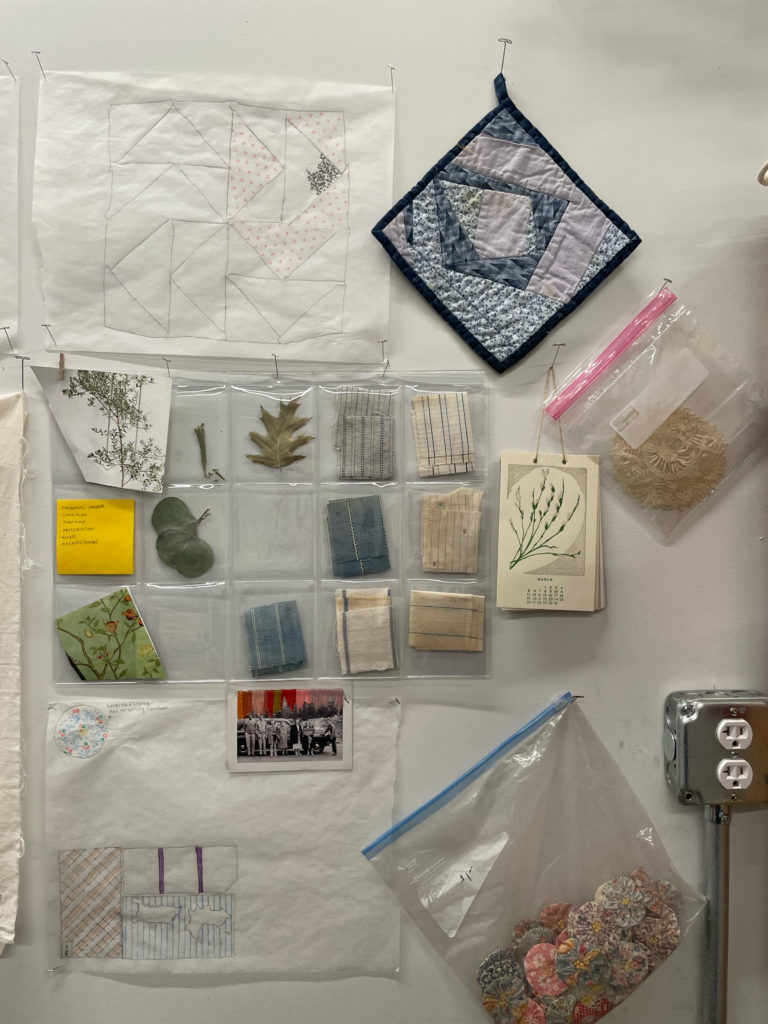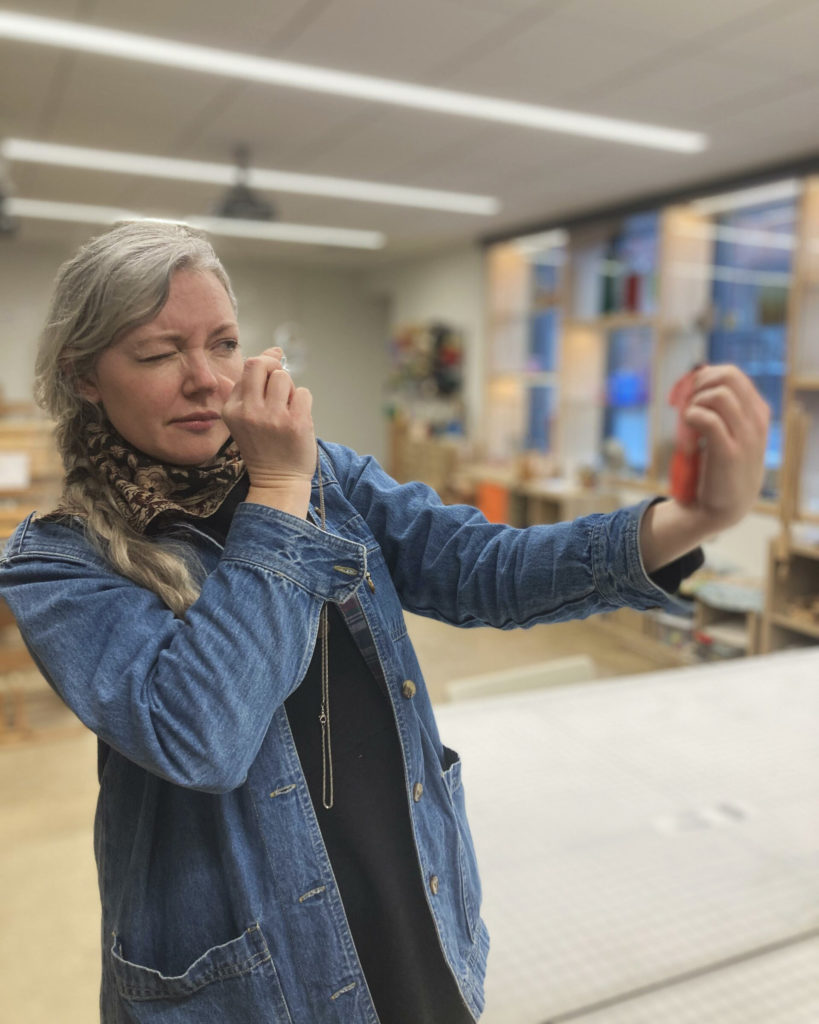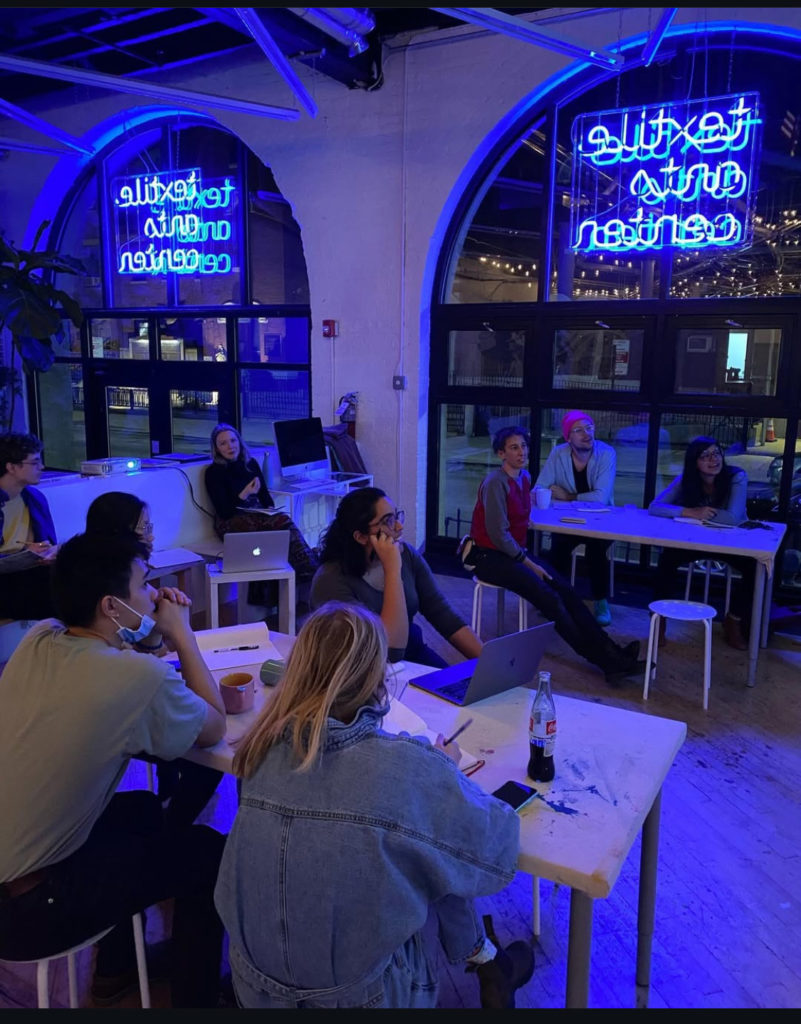AIR Spotlight: Sarah Byrd
Sarah Byrd, an educator and historian, is an essential resource of the Artist in Residence program at TAC. She leads a textile history lecture series as part of the History and Conservation Period in the AIR program. Through her teaching, she creates spaces of dialogue among the residents that are crucial to a greater understanding of textiles as archives and the stories they hold. Questions that Sarah poses concerning the role of language, authenticity, power, trades and perception of textiles, allow the AIR students to adapt further meaning to their own work.
Ciara McNamara, Artist Programs intern at TAC, got together with Sarah Byrd to speak more about her background and current research :
Ciara: I'm curious if you could talk me through what your work is specialized in and what led you down this path?
Sarah: The defining thread that led me down this path has been a constant curiosity about things that are old, specifically things that are textile and fashion-based. I have always appreciated those types of things, and being drawn to them has led me down this very meandering path of studying fashion, and textile history, and finding ways to archive those objects. Additionally, beyond working in archives and teaching classes related to this subject, I have started dipping back into the practice of textiles. My research and lessons are based in theory, but it’s all got to be connected.
Ciara: Have you always been passionate about fashion and textiles?
Sarah: Yeah, it’s a thing that is around us all of the time, so you cannot escape it! Even if you think you’re not paying attention to it, you’re still using it. It never goes away. A friend and colleague of mine explained it best, that the thing that interests me most is all of the stuff that exists around textiles, essentially, figuring out all of the context. The stories that go along with why the textile exists.
Ciara: Why do you believe education is important in terms of textile art and fashion?
Sarah: In one sense, we don’t necessarily think about the importance of textiles, or how they exist as a tool for many other layers of humanness. It’s one of the things I talk about in my classes, how textiles are a form of community building and networks. It’s communication. It's a shelter; it’s problem-solving; it’s math. It is all the things that we do and learn in our elementary education of foundational skills but through the lens of textiles and their origins.

Ciara: What interests you about textile art specifically and what do you think sets it apart from other art forms?
Sarah: Oftentimes, I find myself very stubborn in refusing to maintain the division of textiles from other art forms. However, textile-based art is such an interesting path of materiality to look at as a historian because I get to think through the context of something that has been passed down for tens of thousands of years at this point. It is an amazing expression of concept and material.
Ciara: When was textile art more formally introduced to you?
Sarah: The framework of art divisions really came into my awareness through graduate school. I didn’t have a background in art history or any kind of formal artistic training to establish those concepts. I came from more of an “amateur” point of reference that broadly appreciated the objects that surrounded me. Everyone I’ve encountered has a very different relationship to the language around textiles, so I’ve become curious about the words we choose to call things and how that affects other people's interpretation of them.

Ciara: Could you speak more to how you feel the role of language informs the world of textiles?
Sarah: There is a text that comes to mind that was introduced to me in grad school and has stayed with me in various ways. It is called Women’s Work: The First 20,000 Years by Elizabeth Wayland Barber. It is a seminal text and Barber makes the case for the existence of prehistoric textiles through language, how words exist to provide meaning for things, so there is an association of what words mean. And then how in a theoretical lens fashion and textiles exist as forms of communication. I am always looking to see what the world thinks words mean so I can interpret the space in-between those attributed meanings.
Ciara: Before you came to meet me, you were at the Tatter Library for research, what are you researching?
Sarah: This summer, I am doing an art/research residency, looking into the idea of domestic art. I am very curious about how we look at these practices of decoration and how we create the spaces within our homes. For example, even how you wash your dishes or how you place them onto the dish rack could be viewed as art practice. It gives room to reconsider how creative expression and artistic choices can exist in a space that we wouldn’t really think to call art. If you don’t have another outlet or you haven’t been given permission or privilege to participate in other kinds of art, your outlet can exist within other, lesser-valued forms. I think the act of creation and making art is a universal human experience. Even if you don’t call yourself an artist, you’re still engaging in some practice as a person.
Ciara: That is so fascinating, how would you even begin to research that? What does your process look like?
Sarah: The way I research tends to be centered around a kind of meandering. In the past few years, I have begun to think about research, and the creation of lectures as my creative practice. So, I give myself the freedom to just flow through it all. The thread of Domestic Artists started out during a residency where I reflected on feeling more inclined to work in my home than I do in a studio space. That led me to ask what do I have to do in a studio space to make it feel similar to my home? And then I became curious about the language of setting up a home: why is this called domestic art? Why did it change away from that, or turn into a different thing? How do we shift our relationship to it as culture and related values shift?

Ciara: How did you first come across the Textile Arts Center?
Sarah: I learned about TAC through my fellow fashion textile studies colleagues who had associations with it back in the early days. I would go to the exhibitions and was always really amazed and impressed with what I was seeing and the community that was created around them. Then one of my dear friends who taught the history series for the AIR program moved out of state and suggested me as a replacement. I have been teaching it ever since.
Ciara: It must be very enjoyable observing just how unique the artists' shifting opinions and practices are as the cohorts switch over.
Sarah: It’s true; there are so many unique practices and textiles in so many art forms. I can also see how much has shifted since I started. One of the things I appreciate most about my relationship with the Textile Arts Center is how it’s let me become the teacher I want to be. I feel really lucky that they have encouraged me to shift away from the straight history of textiles and more into explorations of themes and approaches. It is also a great opportunity to remind the artists that they’re not in isolation in this practice, which is sometimes how it can feel.
Ciara: Do you ever incorporate the practice of textiles into your work as a historian and educator?
Sarah: Yes, it is a newer part of my practice, but I have always loved doing needlework. I think it is important in my teaching to understand the physicality, the complications, and really the amount of work it can take to produce different types of textiles, like how strenuous it can feel to actually just thread a needle. You do it and start to understand why needle threaders were invented. If you’re looking to see the difference between a machine stitch and a hand stitch, why don’t you just try it out, train your eye so that you can understand better. In that vein, I started to give myself more space into these practices, taking weaving and natural dyeing classes, as well as doing these things on my own.
It is really nice to be a student when you are the teacher. That is the fun part about spaces like at the Textile Arts Center where everyone coming through the AIR program community is incredibly smart in different ways. There is always an opportunity to be learning.

Ciara: What are a couple of things you have taken away from teaching over the years?
Sarah: I have been so lucky to develop friendships and create partnerships. I love so many of the things that the artists have thought through and how they have taught me to be a different kind of teacher. Every cohort has a very different pattern of thinking that pushes me to be more curious and adapt my own thinking. And then I take that experience into my other education spaces, and further explore what I feel hasn’t been spoken about enough in textile and fashion history as a prompt for their research paths.
Ciara: Are there any artworks or exhibitions say in the past decade that well suit the political climate of the United States currently?
Sarah: Ooh, good question. I was just thinking about this the other day because I am going to see so many exhibitions and feel a sense of overwhelm. There are so many expressions and so many ways to try to get through this. I can’t wait to see how historians are interpreting this moment in 20 or 50 years. It is impossible to contextualize your reality in the moment that it is happening. You cannot necessarily say, “x is a response to y,” because although the artist may say that, there are other external contexts of that time. Why are you trying to figure this out? What has been the context that led you to this moment?
Ciara: Good answer. How about an art piece you saw recently that stuck out to you, perhaps reminding you of the season change as today marks the first day of Spring [March 20].
Sarah: I keep searching for evidence of the people who made the thing who leave their initials written somewhere. I was just admiring a piece in Tatter’s collection that is a seemingly unfinished sampler. The threads are not quite all there, it’s been started but it is unclear if it is still in progress or if the loss happened over time. I feel that in this transition of everything; culture, politics, climate; we are in a place where the language is completely shifting. And we don’t have the full picture, just the pieces we can see in front of us now, like the sampler.
Ciara: What is your favorite era and type of textiles at the moment?
Sarah: When you are taught how to be a historian, you learn how to look at everything differently. My area of knowledge is anchored in early 20th-century America, broadly before 1940. The nation was grappling with established industrialization production and how that was changing society, as well as the politics around who does what and how the world looks. There are a lot of radically different things that come out of that time in a design or aesthetic space.
Ciara: And when you say, being taught to be a historian you are taught this and that…What does being a historian mean to you?
Sarah: I believe my educational background, along with my personal and professional experiences have really taught me to think about it like this: How do you look at things not to find an answer but instead to find more questions.
A love of all things “old” led Sarah to collections and preservation of the past in order to understand the present. Her work as a fashion and textile archivist includes large corporations and private clients, with a special focus on American designers and the artifacts of daily living. She currently teaches courses related to the history, preservation, and material culture of fashion and textiles at the Fashion Institute of Technology, New York University, Parsons School of Design, the Textile Arts Center and is a co-founder of the Fashion Studies Alliance.
About the AIR program:
TAC AIR combines studio access with a rigorous interdisciplinary curriculum, and regular critical dialogue, providing residents an opportunity to learn and explore the textile medium, and an alternative to traditional higher education programs. The residency culminates in a group exhibition produced and hosted by TAC. Since 2010, TAC AIR has graduated over 100 artists and designers whose work continues to further textile art within the fashion, fine arts, design and art education fields.